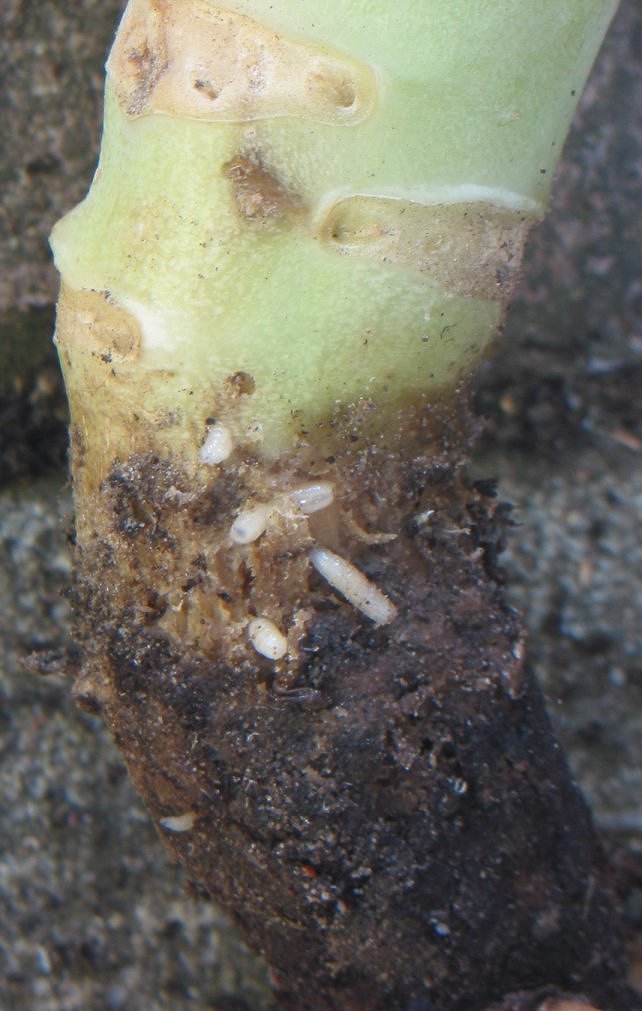Root Fly on:
[Wikipedia]
[Google]
[Amazon]
''Delia radicum'', known variously as the cabbage fly, cabbage root fly, root fly or turnip fly, is a pest of
 The first sign of the presence of the larvae is a delay in plant growth accompanied by the withering of leaves which develop a bluish tinge. The larvae are found on cabbage, turnip, swede, radish, and other cruciferous crops. Sometimes, 300 larvae can be found on one plant, damaging the inner parts of the main root and disrupting the transport of water and nutrients to the stem and leaves causing the death of many plants.
The first sign of the presence of the larvae is a delay in plant growth accompanied by the withering of leaves which develop a bluish tinge. The larvae are found on cabbage, turnip, swede, radish, and other cruciferous crops. Sometimes, 300 larvae can be found on one plant, damaging the inner parts of the main root and disrupting the transport of water and nutrients to the stem and leaves causing the death of many plants.
crops
A crop is a plant that can be grown and harvested extensively for profit or subsistence. In other words, a crop is a plant or plant product that is grown for a specific purpose such as food, fibre, or fuel.
When plants of the same species a ...
. The larvae of the cabbage root fly are sometimes known as the cabbage maggot or root maggot. ''Delia brassicae'' (or ''Hylemya brassicae'') was the most common name in literature prior to 1981. The adult flies are about 1 cm long and are grey in colour, but otherwise resemble the common house fly
The housefly (''Musca domestica'') is a fly of the suborder Cyclorrhapha. It possibly originated in the Middle East, and spread around the world as a commensal of humans. Adults are gray to black, with four dark, longitudinal lines on the t ...
.
The flies can be found all over Europe. After overwintering as pupa
A pupa (; : pupae) is the life stage of some insects undergoing transformation between immature and mature stages. Insects that go through a pupal stage are holometabolous: they go through four distinct stages in their life cycle, the stages th ...
e in the soil
Soil, also commonly referred to as earth, is a mixture of organic matter, minerals, gases, water, and organisms that together support the life of plants and soil organisms. Some scientific definitions distinguish dirt from ''soil'' by re ...
, the flies emerge in spring, feed on nectar
Nectar is a viscous, sugar-rich liquid produced by Plant, plants in glands called nectaries, either within the flowers with which it attracts pollination, pollinating animals, or by extrafloral nectaries, which provide a nutrient source to an ...
, and lay eggs
An egg is an organic vessel in which an embryo begins to develop.
Egg, EGG or eggs may also refer to:
Biology
* Egg cell, the female reproductive cell (gamete) in oogamous organisms
Food
* Eggs as food
Places
* Egg, Austria
* Egg, Switzerland ...
close to plants of the genus
Genus (; : genera ) is a taxonomic rank above species and below family (taxonomy), family as used in the biological classification of extant taxon, living and fossil organisms as well as Virus classification#ICTV classification, viruses. In bino ...
''Brassica
''Brassica'' () is a genus of plants in the cabbage and mustard family (Brassicaceae). The members of the genus are informally known as cruciferous vegetables, cabbages, mustard plants, or simply brassicas. Crops from this genus are sometim ...
''. The eggs are white and about 1 mm in diameter. They hatch into white maggot
A maggot is the larva of a fly (order Diptera); it is applied in particular to the larvae of Brachycera flies, such as houseflies, cheese flies, hoverflies, and blowflies, rather than larvae of the Nematocera, such as mosquitoes and cr ...
s after about six days and the larva
A larva (; : larvae ) is a distinct juvenile form many animals undergo before metamorphosis into their next life stage. Animals with indirect development such as insects, some arachnids, amphibians, or cnidarians typically have a larval phase ...
e feed for about three weeks on the roots and stems of the cabbage plants. After this, the larvae are typically 0.9 to 1 cm in length and form reddish-brown pupae which hatch into adult flies after around 20 days. This species is univoltine
Voltinism is a term used in biology to indicate the number of broods or generations of an organism in a year. The term is most often applied to insects, and is particularly in use in sericulture, where silkworm varieties vary in their voltinism.
...
(has one generation per year) in northern Europe and bi- or trivoltine in central Europe.
Economic significance
 The first sign of the presence of the larvae is a delay in plant growth accompanied by the withering of leaves which develop a bluish tinge. The larvae are found on cabbage, turnip, swede, radish, and other cruciferous crops. Sometimes, 300 larvae can be found on one plant, damaging the inner parts of the main root and disrupting the transport of water and nutrients to the stem and leaves causing the death of many plants.
The first sign of the presence of the larvae is a delay in plant growth accompanied by the withering of leaves which develop a bluish tinge. The larvae are found on cabbage, turnip, swede, radish, and other cruciferous crops. Sometimes, 300 larvae can be found on one plant, damaging the inner parts of the main root and disrupting the transport of water and nutrients to the stem and leaves causing the death of many plants.
References
{{DEFAULTSORT:Delia Radicum Anthomyiidae Agricultural pest insects Flies described in 1758 Diptera of Europe Taxa named by Carl Linnaeus